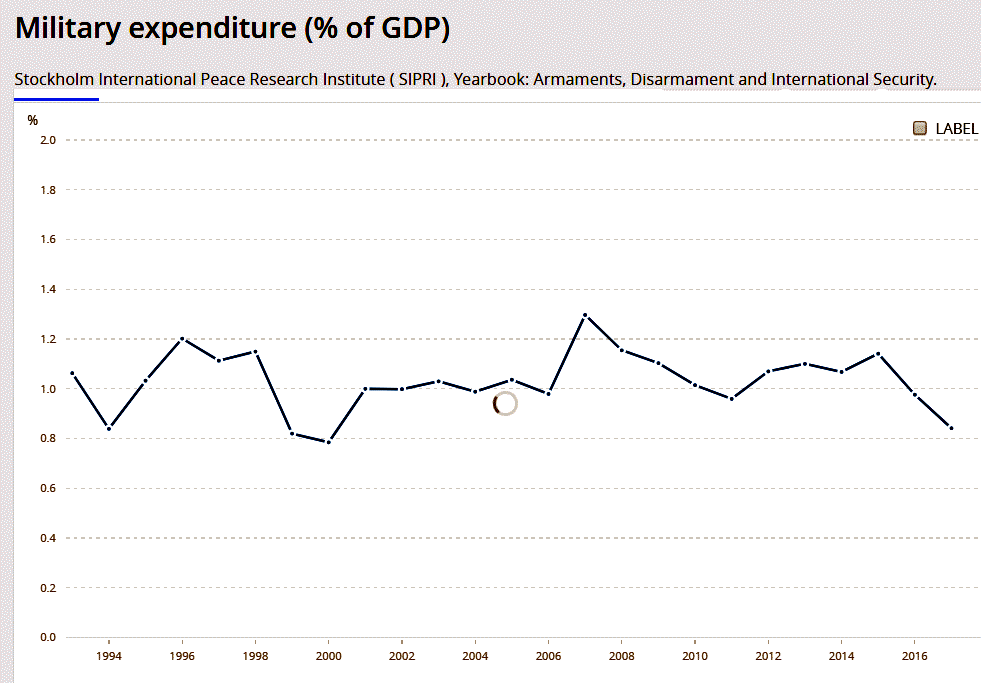Kazakhstan - Military Spending
 During the 1990s, defense spending was a low priority, and this was only addressed after improved national economic performance. The 2001 military budget was 25 billion Tenge ($172 million), representing an increase of around 8 billion Tenge on the previous year. This may be viewed in perspective when read alongside the National Budget plans for 2002, affording 42 billion Tenge on building and reconstructing roads. The Armed Forces of Kazakhstan remain markedly under-financed.
During the 1990s, defense spending was a low priority, and this was only addressed after improved national economic performance. The 2001 military budget was 25 billion Tenge ($172 million), representing an increase of around 8 billion Tenge on the previous year. This may be viewed in perspective when read alongside the National Budget plans for 2002, affording 42 billion Tenge on building and reconstructing roads. The Armed Forces of Kazakhstan remain markedly under-financed.
Defense funding increased substantially in 2003, and as a result more resources were received for personnel, training, and equipment maintenance; although Kazakhstani defense officials were slow to recognize that more resources did not automatically result in higher readiness. The number of properly trained and experienced officers is generally satisfactory, but there continued to be a shortfall in skilled noncommissioned officers (NCOs). Investment plans are primarily geared toward improving living conditions for personnel and acquiring interoperable command and control equipment, but there were few plans for the upgrading or replacement of obsolete basic armament in the near future.
Following the course, selected according to a long-term development strategy to the year 2030, proposed by their leader, President of the country N.a. Nazarbaev, Kazakhstan is continuing its intensive development, including in the defense system. The head of State in his annual Message to the people of Kazakhstan pays special attention to the development of the armed forces, other troops and military formations, identifies the steps necessary for creating a professional army capable of rapid deployment, corresponding to the highest international standards.
"The armed forces of Kazakhstan should be provided with modern military equipment, they rightly expect the highest defense technology, the threats that are specific to Kazakhstan and the new international situation," the President said in his message to the people of Kazakhstan «Kazakhstan's strategy of joining the 50 most competitive countries of the world. Kazakhstan on the eve of a new leap forward in its development "(March 2, 2006).
Kazakhstan’s military relies on largely decrepit, Soviet-era heavy equipment, and its defense budget is still, by global standards, paltry: In 2010, the country budgeted $60 million for procurement of new equipment. However, when the world financial crisis ends and with oil revenues expected to increase significantly over the coming 10-15 years, Kazakhstan has laid out ambitious plans to modernize its armed forces.
Having an army is a very expensive, therefore, not every country in the world can rapidly update its fleet of military vehicles. By 2013 the speed with which the task to update annually the fleet of modern models of weapons of military equipment was set at 7%. This would enable Kazakhstan within 7-10 years to have a military composed of up to 70% percent or more modern weapons of military equipment that meet the requirements of major foreign armies in the world. There is no army in the world, where 100% is equipped with modern military equipment. Each military equipment has a certain life cycles. During this life cycle designer and developers of the weapons leave the potential for further modernization. On this basis, by 2013 in certain areas – telecommunications, communication – up to 30% on major weapons is nearly 16%. There is also an inverse pattern that arming military equipment affects the form and methods of warfare. On this basis, examining trends in the global arms market, examining the experience of the last local wars and armed conflicts, the Ministry of Defense and the General staff continually revise their key performance indicators. But in General, they believe that at the rate of 7-10% updates is the rate at which the military will possess the most modern arms equipment

|
NEWSLETTER
|
| Join the GlobalSecurity.org mailing list |
|
|
|

